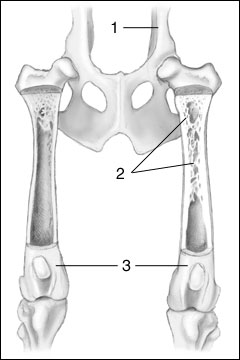Affecting young, rapidly growing dogs of larger breeds, panosteitis is a disease that causes inflammation in the marrow cavities of long bones such as the humerus, radius, ulna, femur, and tibia. This inflammation leads to pain and the production of reactive bone that results in lameness and sometimes fever.

- Pelvis
- Lesions of Panosteitis
- Femur
Because it can affect different bones at different times, frequently the lameness will "shift" from limb to limb. These cycles of lameness may last from two to three weeks for each affected bone. Often, there will be periods of apparent normalcy between the periods of lameness. Fortunately, although very painful, the disease usually disappears when the dog reaches maturity.














